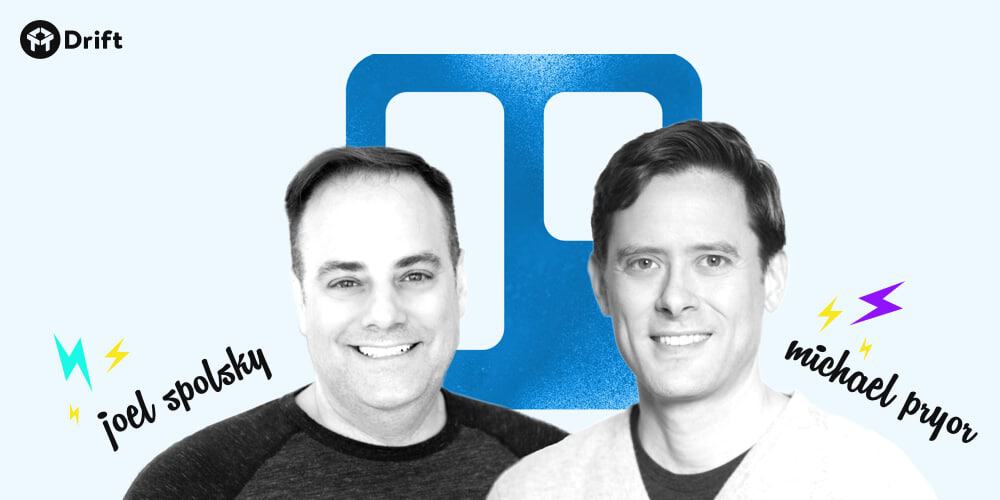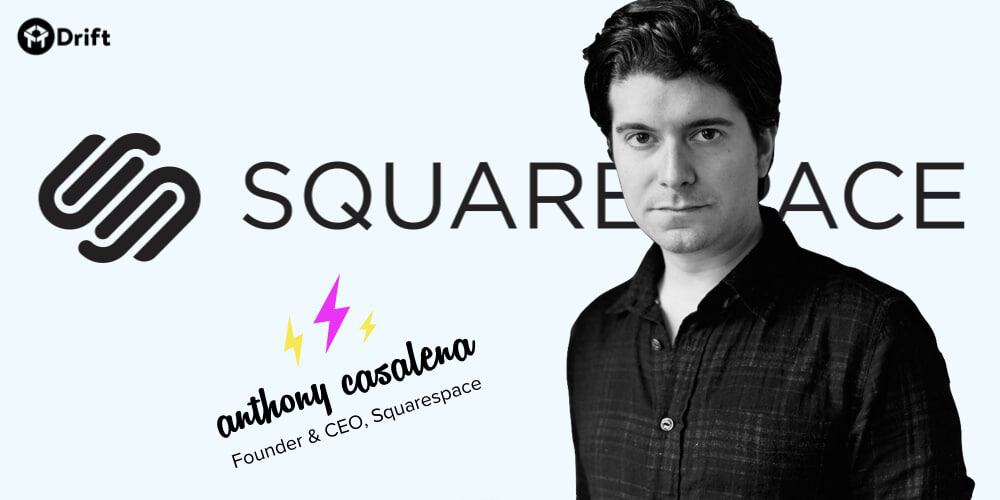
If you manage a website or blog — or regularly listen to podcasts — there’s a 99.999% chance you’ve heard of Squarespace. And considering the website creation company now boasts more than 2 million paying customers, there’s also a decent chance that you either a) use Squarespace yourself or at least b) know someone who does.
Thirteen years ago, when college student Anthony Casalena founded Squarespace in his dorm room, there was no way he could have predicted the extraordinary growth his business would achieve. Because the reality was, at the time, Casalena wasn’t focused on building a business.
He was focused on building tools that could help solve his own problems.
As Casalena told Entrepreneur in 2016: “I never learned programming or design because I wanted to be an entrepreneur or make a business. I did it because I wanted to make things.”
What Casalena ended up making — an easy-to-use platform for building beautiful websites — turned out to be something a lot of people could see value in. So much so, in fact, that people literally began knocking on his door and offering him money in exchange for using it. As he explained in 2018:
“There was a moment in my dorm room when I was still developing Squarespace where a friend offered me some small amount of money for the platform, thinking it would be useful for his website. It helped me realize that the problem I was solving for myself was something a lot of people might be struggling with.”
Thanks to a $30,000 loan from his father, Casalena was able to get Squarespace off the ground in 2004. In that first year, his company earned around $50,000 in revenue. By 2006, annual revenue exceeded $1 million. Flash forward to 2017 (the most recent year we have revenue numbers for), and, as you can see in the graph below, Squarespace pulled in a whopping $300 million in annual revenue, which is 6,000x what it earned in its first year.

Over the years, Squarespace has raised a total of $279 million in venture capital funding. And, following its largest round of funding in 2017 ($200 million), Squarespace is now valued at $1.7 billion.
Not too shabby for a company that started out in a dorm room (or, ya know, for any company).
So, how the heck did Squarespace achieve such staggering growth?
☝️That’s the $1.7-billion dollar question. In this post, I’m going to do my best to answer it. While there are countless factors that led to Squarespace growing from a dorm-room dream into a billion-dollar behemoth, I’ve identified four key factors that were essential to Squarespace’s growth strategy. Here’s the tl;dr version for those of you in a hurry:
- Find your niche. Squarespace entered a crowded market. By focusing on beautiful design, they were able to carve out a piece of the pie for themselves.
- Hire based on shared core values. When it comes to getting hired at Squarespace, having a “designed-focused mindset” is more important than raw talent.
- Don’t be afraid to make a splash. Squarespace has run ads during five consecutive Super Bowls and is an advertising mainstay on several podcasts (which helps explain how Squarespace became a household name).
- Prioritize long-term growth. Squarespace’s CEO isn’t looking for a quick exit. Instead, he’s focused on scaling Squarespace’s mission to match his customers’ ambitions so that the company can “grow as they grow.”
1) Find your niche.
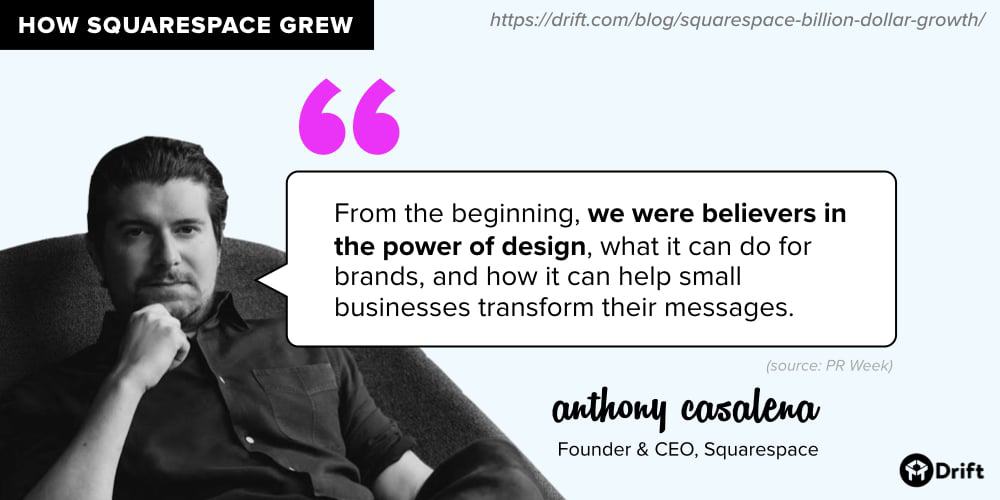
When you think about Squarespace, what’s the one defining characteristic that first pops into your mind?
I know that for me, it’s beautiful design. That’s what Squarespace is known for. In a world with nearly 2 billion active websites, and where WordPress dominates the website creation space, powering 32% of all websites on the internet, Squarespace still managed to carve out a niche for itself and become successful, not to mention profitable.
And here’s the thing:
It didn’t happen by accident.
From the very beginning, Squarespace founder and CEO Anthony Casalena focused not only on developing a platform that would make the website creation process easier but also on developing a platform that would make websites more beautiful. The form was just as important as the function. As Casalena told First Round Review:
“None of the products out there took style or design into account — which doesn’t work when you’re trying to build your personal identity online. Your website is where your ideas live. It reflects who you are. And all there was out there were these geeky, bargain-bin sort of services charging $2.99 a month for clunky experiences.”
To solve this problem, Casalena made high-quality design both a core value of his product and a central focus of his marketing efforts. Design wasn’t just important to Squarespace, it was the lifeblood of the business and a defining aspect of Squarespace’s company culture. As Casalena explained in an interview with PRWeek:
“We have a distinct DNA. And it isn’t faked or plastered on after the fact. From the beginning, we were believers in the power of design, what it can do for brands, and how it can help small businesses transform their messages. That, joined with our intense engineering focus, is what defines us. We’re trying to communicate that to consumers who see us out in the market. The purity of what we do helps us stand out in a crowded field of noisy competitors.”
The takeaway here: Your company will never be able to capture market share in a crowded space with a bland product and a bland message. In order to achieve Squarespace-level growth, your company needs to stand for something and distinguish itself by highlighting a core value. (In Squarespace’s case, that’s design.)
2) Hire based on shared core values.
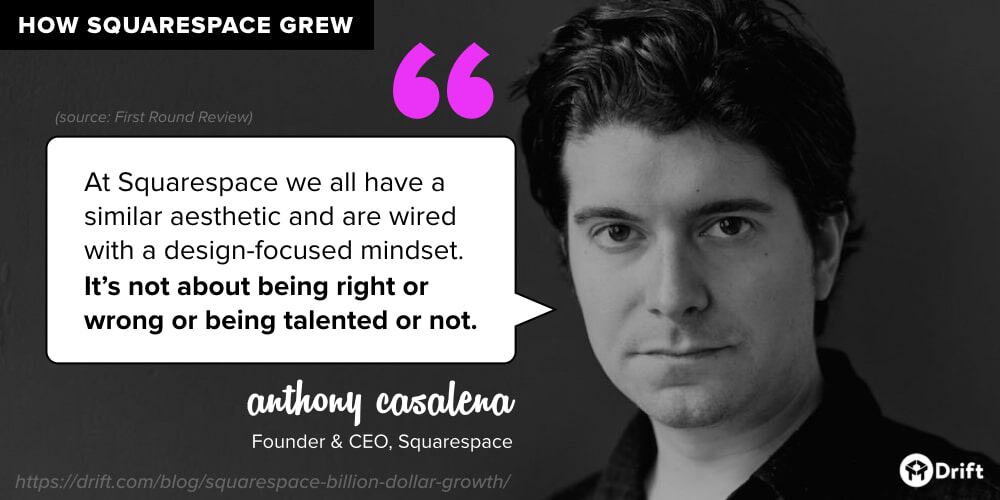
This next lesson ties directly into the first we looked at: Once you’ve carved out your niche and identified your company’s core value, or values, you need to make sure you hire based on those values. Because that’s how you build a company that, from the very beginning, is strategically aligned.
As Casalena told First Round Review:
“You want to all be fighting for the same thing. For example, at Squarespace we all have a similar aesthetic and are wired with a design-focused mindset. It’s not about being right or wrong or being talented or not. I always think whether they would or could be a lot happier or more successful elsewhere, and if the answer’s yes we don’t make the hire… When you have your mission and core values developed, then anyone at the company can point to them and say, ‘This is what makes us uniquely Squarespace. This is the way we do things.’”
For most companies, skills and experience would, not surprisingly, be the most important attributes they look for in new hires. But Squarespace isn’t like most companies. For Casalena, rallying like-minded people around your core values is more important than hiring people based solely on talent.
“I really think, when you get the right people around the right idea, amazing things are possible. Things you never imagined,” he explained to First Round Review. “And I think that’s part of how I’ve managed to run the company for so long — wanting to see what was possible when all the right elements came together.”
Of course, those “right elements” don’t always come together right away. Ultimately, you’ll only be able to narrow in on what an ideal hire looks like by first weeding out those non-ideal hires. Or, as Casalena put it in an interview with Entrepreneur:
“I’ve learned a lot from the hires at Squarespace that didn’t work out. Learning from these situations has helped reshape how we hire and how we think about success in various roles. This especially helped me early on, where I frequently hired for certain skills I thought I didn’t have, even though they were skills I needed to learn to become a better leader. Conversely, I neglected to hire for certain roles that I really needed due to a complete blind spot in how I was thinking about our business. These situations drastically changed how I run Squarespace today.”
3) Don’t be afraid to make a splash.
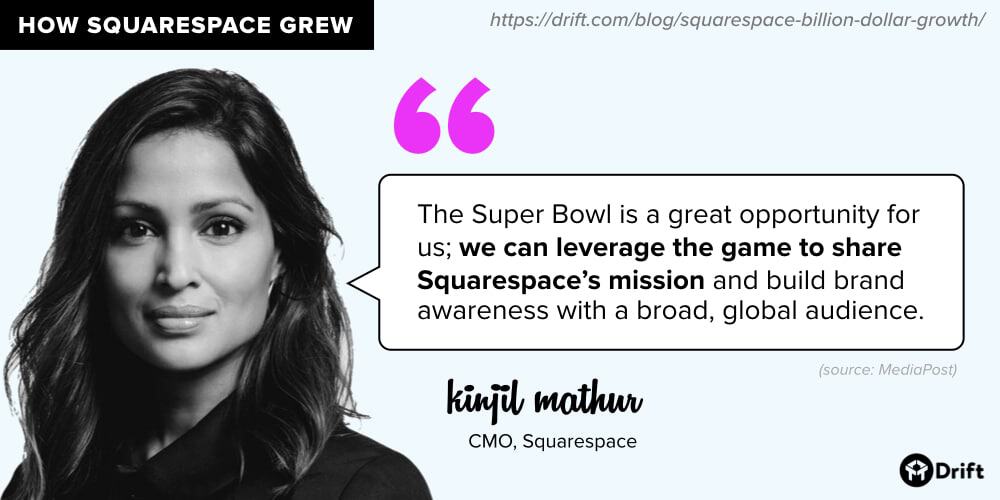
Five million dollars for a thirty-second TV commercial during the Super Bowl … worth it?
If you asked Squarespace’s CMO, Kinjil Mathur, the answer would be a resounding “Yes.”
While to some it might seem wasteful, for Squarespace, the brand exposure that comes with buying Super Bowl ads more than makes up for the cost. What’s more, the timing of the Super Bowl aligns perfectly with when Squarespace’s target customers are likely to be thinking about buying. As Mathur explained to MMediaPost:
“At the beginning of the year, there is a natural urge for people to pursue their passions, start new adventures, and plan their next move. Timing-wise, the Super Bowl is a great opportunity for us; we can leverage the game to share Squarespace’s mission and build brand awareness with a broad, global audience.”
When you consider that Squarespace has now run ads in five consecutive Super Bowls (including in 2018, when they ran an ad featuring a motorcycle-riding Keanu Reeves), it’s clear that the company has been satisfied with the returns they’re getting from this pricey channel.
Of course, if you listen to NPR podcasts like Serial or This American Life, you know that Squarespace isn’t only investing in TV ads — the company has been a pioneer in the art of podcast advertising. Here’s how Casalena explained Squarespace’s strategy to PR Week:
“For podcasts, there’s a unique opportunity to sponsor independent voices that have targeted content and a great connection with their audiences. We started in tech podcasts and grew from there. As Squarespace became more broadly used, you can see that strategy reflected in the kinds of podcasts we advertise in, getting broader and broader and more mainstream.”
The bottom line: Squarespace isn’t just focused on building a great team and a great product — they’re focused on getting the word out about the great product that their great team is building.
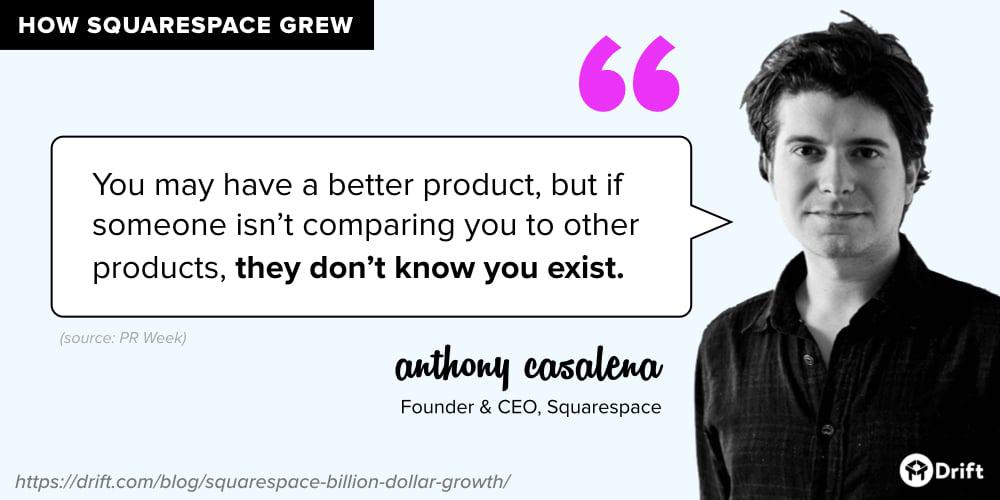
Back in 2016, Casalena said that Squarespace’s biggest challenge was brand awareness. “You may have a better product,” he explained, “but if someone isn’t comparing you to other products, they don’t know you exist.”
By making a splash with Super Bowl and podcast ads, Squarespace has been able to transform itself from a website creation company only known among techies to a household name and global brand.
Oh, right, and just for good measure, in 2017 Squarespace became the first jersey sponsor of the New York Knicks, exposing millions of NBA fans to the Squarespace logo. The logo now appears on the shoulder of every New York Knicks jersey — opposite Nike’s (who makes the jersey).
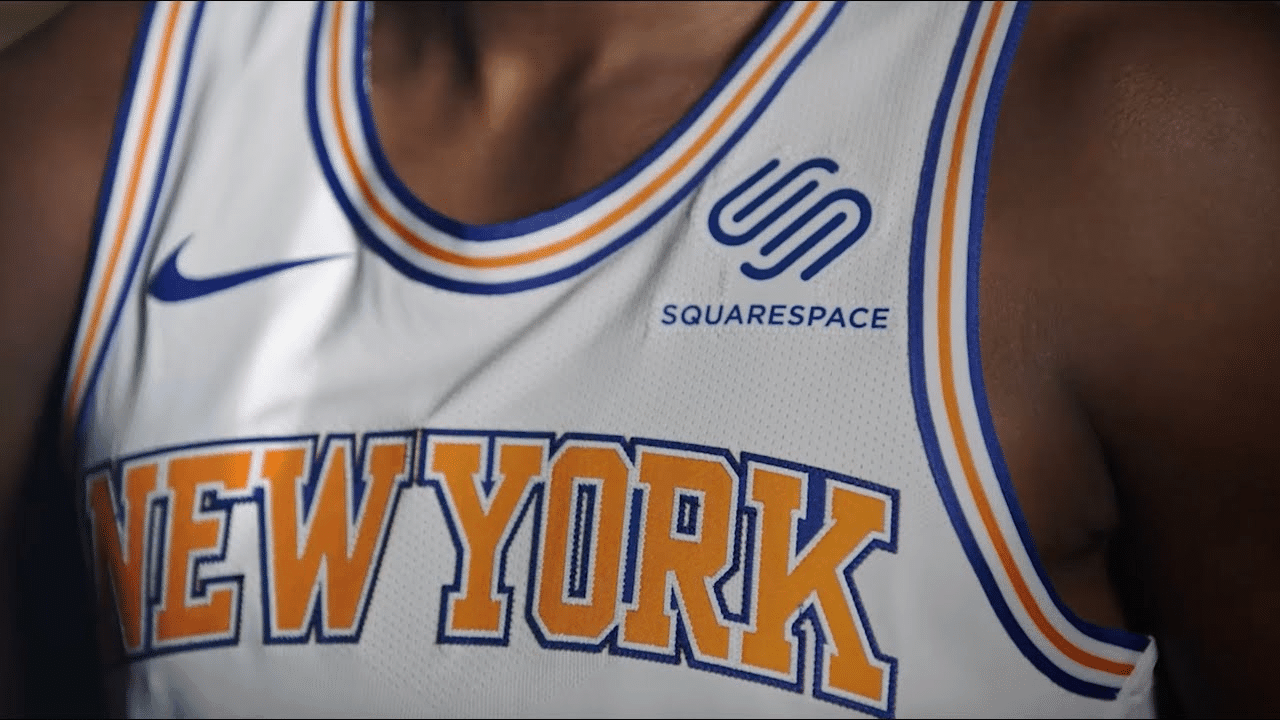
(image credit: New York Knicks)
Will Squarespace’s logo ever become as recognizable as the almighty Nike swoosh? If Squarespace continues to make a splash with its advertising campaigns, and keeps finding new opportunities for driving brand awareness, it just might.
4) Prioritize long-term growth.
For many dorm-room entrepreneurs who have aspirations of building billion-dollar companies, there’s a temptation to raise as much funding as possible from VC firms. After all, that money gives you the ability to rapidly grow your team, take more risks, and, more generally, keep sustaining your operation until you’re able to become profitable.
Casalena, however, took a different approach when he launched Squarespace. Instead of focusing on raising money, he focused on making money. As he told Entrepreneur,
“I’ve actually tried to minimize the amount of money I’ve had to raise for the business. Squarespace has always been a company that generates revenue, so our dependence on outside capital has always been quite limited.”
As a result of this limited dependence on outside capital, Casalena essentially forces Squarespace (and himself) to prioritize making fixes and improvements that will serve the company in the long-term versus simply throwing money at problems and patching them up temporarily. As Casalena explained:
“We’ve operated the business very efficiently as a result. That mindset has forced us to be operationally efficient and has helped avoid situations where we’re throwing cash at a problem that actually requires time and people to fix.”
When Casalena has opted to raise outside capital, he’s always done so in a very deliberate manner. In addition to thinking about how he’ll spend VC dollars on his business in the present, he also thinks about what kind of returns those VCs will expect in the future — including in a decade from now. To quote Casalena:
“The rounds we have raised have been used in very specific and strategic ways in our history, versus rounds that we’ve had to raise to ‘keep it going’ or to try and prove our model. All that said, I think it’s important for anyone raising capital to understand what the exit terms are on that money. Do your investors want to be in for a year? A decade? What kind of return qualifies as a success for them, and how do they want to achieve that result with you? It’s important to keep everyone aligned around outcomes and timeframes.”
The discipline that Casalena has shown here has clearly paid off. His prioritization of long-term planning over short-term gains has helped Squarespace achieve not only exceptional growth, but sustainable growth.
Ultimately, Casalena plans on staying with Squarespace for the long-haul. And while he has no intention of ever changing the company’s core values, he is expanding Squarespace’s mission beyond helping people build websites in order keep up with the evolving needs of customers and to sustain the company’s growth. As Casalena told First Round Review:
“The reason I’m at Squarespace 10 years in is because I want to be here 20 years in and 30 years in. We’re not just working to solve the problem of making websites. We’re working to solve the problem of self expression.”
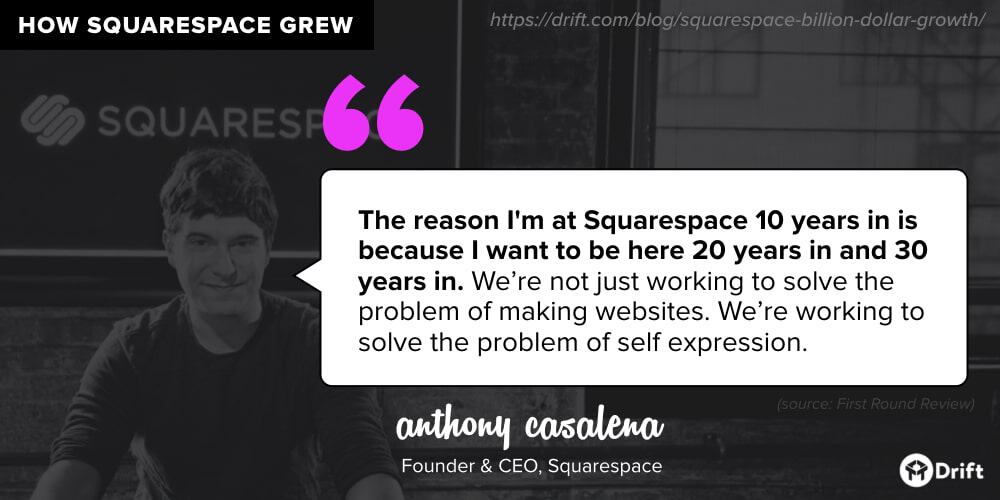
The big takeaway here: Forget about growing for the sake of growing. You need to have a long-term goal for what you’re building and what you’re trying to accomplish. For Squarespace, that goal is to build tools that help people express themselves and bring their unique visions to life. To quote Casalena:
As we grow, the clearer it becomes how many creative tools we can make available to people to realize their own visions. People are creative in ways that go a lot deeper than building websites. We want to scale our mission with their ambition, and grow as they grow.”
Final Thought
So there you have it: The four secrets behind how Squarespace grew from a dorm-room idea into a billion-dollar company. And while not all of the tactics mentioned here (re: buying Super Bowl ads) will be feasible for every sales and marketing team, we hope that they’ll at least serve as inspiration for future campaigns.
Need a quick recap of what you learned from Squarespace? Here’s a cheat sheet:
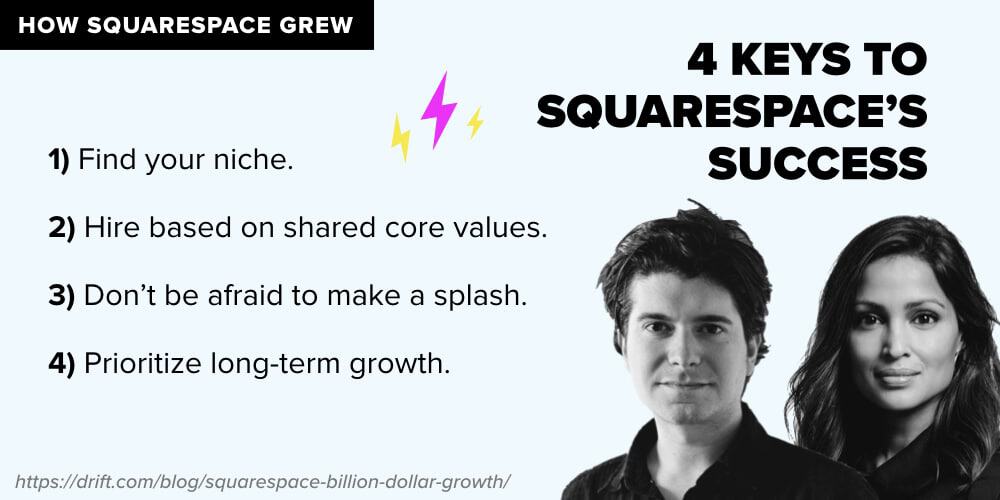
One final tidbit about Squarespace before you go: As a result of their extraordinary brand and business growth, the company took the number 8 spot in Forbes’ 2018 Cloud 100 list, which is a ranking of the world’s top private cloud computing companies.
Want to learn more about how Squarespace (and other Cloud 100 companies) are running their sales & marketing? Check out our 2018 Cloud 100 report.






